The identity and style of a team’s midfield forms the blueprint for their entire gameplay and is directly proportional to the success they have. For this midfield to have a proper effect on the team, it needs for its members to be well versed with each other and complement each other well to get the best out of their respective games and have the desired effect on the team.Many teams have faltered, despite having an extremely skilled midfield. So, talent alone does not make the difference, good camaraderie and a working partnership are just as important. Here's a brief analysis of some of the best midfield duos in Europe right now.
#7 Barcelona
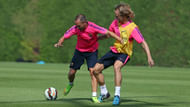
Barcelona's European domination was built on the solid foundation provided to them by the duo of Xavi and Iniesta. Their talent and ability to work in tandem created a lot of inconveniences for those who played against them. It was a glorious midfield combination.
Fast forward a few years and the Barcelona midfield doesn't look the same. Xavi has been replaced by Rakitic, a gifted individual, but the change has failed to create the spark seen during the Xavi-Iniesta time. Rakitic does not impose himself on the game as much as Xavi did, and Iniesta has, oddly, been out of form. Barcelona are losing their dominance in the center of the pitch and are increasingly having to rely on the genius of the front three - Messi, Neymar and Suarez a lot. It has been utterly chaotic for them in midfield recently.
It was evident against PSG, it was evident against Real Madrid and then again, against Celta Vigo. Iniesta has failed to act as the link between the midfield and attack, causing Messi to drop deeper into midfield. Rakitic has been shunted out wide to keep the markers busy, which is a very odd tactic pursued by Luis Enrique. This has caused a vacuum in the center of the pitch and has been a cause for consternation among the fans. It has also resulted in the tiki-taka dominance has gone.
Barcelona have faired decently thus far, but fears persist about their ability to carry on in this manner. Teams are, at some point, going to figure out this weakness and exploit it, just as Celta did. The midfield is in need of an urgent face lift.
Rating: 6/10
#6 Manchester City
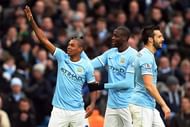
Manchester City have struggled off late and their problems have become more pronounced. It is not unusual for City to look so haggard, but it is unlike them to not have a hero to pull them out of their rut.
Last season, it was the combination of Fernandinho and Yaya Toure that helped them navigate though perilous times. This season, even those two have fallen on hard times. The two operate in a double pivot with Toure starting deeper than Fernandinho but with the freedom to bomb forward, while Fernandinho is tasked with breaking play up and laying the ball off to the more creative players.
The two have looked woefully out of form and this has resulted in lackluster defensive displays, with no real steel in front of the back four to offer any sort of protection. The attack too, has been overly reliant on David Silva, with Toure failing to find the form that propelled City to the title last season. Their play is incredibly lackadaisical at the moment and they are just going through the motions. If they need to have a real chance of winning any silverware this season, they need their midfield combination to stand up and be counted again.
Rating: 6/10
#5 Real Madrid

There were many naysayers when Madrid swapped Xabi Alonso for Toni Kroos. Kroos, unlike Alonso, has no nous in defending or being a physical presence in midfield. The move just didn't make sense and results in the first few games did nothing to assuage the fears of the fans. Eleven games later, Madrid sit atop the La Kiga table having plundered 42 goals.
Madrid's style this season has been distinctly different. The quick, pacy madness of last season has been replaced with a more calm, possession oriented system. This is mostly because of Modric and Kroos. Without the aid of a midfield bruiser, Ancelotti has been forced to alter the style of his team.
Kroos and Modric have both been incredibly disciplined and shown great tactical awareness in the initial stages of their blooming partnership. They make up for their deficiencies with smart positioning and lower the game's tempo in the middle so that they're not caught out of position.
In attack, they've helped Madrid become a more multi-pronged system with their effective distribution of the ball. Together, they have contributed 8 assists and 2 goals in the league this season.
Though it has been a good start, weaknesses are still obvious. Madrid haven't been seriously tested by anyone as yet and when they were, they succumbed to defeats against Sociedad and Atletico. However, time is on their side and this midfield combination might just evolve into an unbreakable force (once Modric is back from the injury he sustained while on international duty this week)
Rating: 7/10
#4 Juventus

It is very hard to pinpoint a midfield duo in this Juventus team given their propensity to feature a large number of midfielders, but if one had to be picked, it would be the duo of Pogba and Vidal.
From Conte's 3-5-2 to Allegri's 4-3-3, this duo has been a constant. It is difficult to analyse this partnership as neither of the players can be defined conclusively. Often times, in a partnership, one player is expected to be more attacking while the other is a bit more reserved. Between Pogba and Vidal, it hard to tell who is more defensive and who has better attacking instincts, as both are complete midfielders.
Both players are exemplary workhorses and do not like shunning their duties. The two can often be seen running back and throwing in tackles, if not covering for some other player who is woefully immobile. In attack, Pogba is the more proactive one as he likes to dribble and take shots on goal, while Vidal prefers passing the ball around and arriving late in the box to try and finish moves.
The duo form a very dynamic and aggressive midfield, one that any team would be fortunate to have. The one thing this duo lacks is creativity which is provided for them to take advantage by one of the Italian midfield duo of Marchisio or Pirlo.
Rating: 8/10
#3 Atletico Madrid
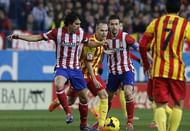
The midfield forms the engine of the team. It is expected to win back possession, maintain possession and eventually, create goals. Every deficiency of a team can ultimately be traced back to its midfield. It is then a bit surprising to see that two of the most underrated players from the all conquering Atletico Madrid side are its two central midfielders, Gabi and Tiago.
The aforementioned duo are not particularly known for their skills on the ball or for threading picturesque through balls. They're not goal scorers either, and so quite different from some of their counterparts. They are midfielders of the off-beat variety. They don't catch the eye, but are very efficient players.
Atletico are not hoarders of the ball. They averaged less than 50% possession enroute to their title win last year and have averaged only 49% possession this season. They are most effective without the ball. Simeone likes to play a 4-4-2 formation with Tiago and Gabi tucked into the middle of the pitch, where the team are very compact without the ball.
When not in possession, the strikers try to force the opposition defenders to pass the ball to the wide areas. With the wide midfielders tucking in and the fullbacks pushing up, it creates a two on one situation, triggering a pressing trap. In this scenario, the wide midfielder and the fullback are expected to harry the opposition till possession has been turned over.
While the ball-player's space is being occupied by the wide midfielder and the fullback, Tiago and Gabi spring into action. They survey the passing options and cut them out, thus isolating the opposition player on the ball. This increases their team's chances of winning back possession and countering quickly.
Should the strikers fail to push the play to the wings, the strikers and the wide midfielders converge to the center, cutting out all passing avenues, while Tiago and Gabi press aggressively. Gabi, positioned higher, is the more aggressive one, while Tiago cleans up behind him.
In attack the duo help build attacks from the back, bringing the ball out of defense and allowing the full backs to overlap. Though they are not expected to maraud frequently into forward positions, occasional forays into the box are always on the cards. This again shows their efficiency as Gabi has three assists this season while Tiago has got on the score sheet twice.
Rating: 9/10
#2 Chelsea
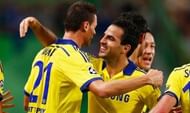
Chelsea have formed, what looks like the most formidable midfield partnership in the Premier League in recent years. Chelsea acted quickly in the last two windows to secure the signings of Fabregas and Matic, and seeing their performances, it has become evident why.
Matic is probably the only prominent midfield destroyer playing in Europe right now. Teams have shifted to more technical players doing away with the midfield enforcer in the process while Mourinho has opted for the exact opposite. In isolation, it looks like an overtly conservative move by the manager, but when viewed in conjunction with the purchase of Cesc Fabregas, it makes complete sense.
The two have combined well to camouflage each other's weaknesses. Fabregas' creativity more than makes up for Matic's lack of the same while Matic's defensive capabilities easily mask Fabregas'. This has resulted in a juggernaut of a midfield that has been very hard for the opposition teams to cope up with. The duo have combined to produce 11 assists and 2 goals for the team this season.
Rating: 10/10
#1 Bayern Munich

This is, perhaps, the most unconventional midfield partnership football has ever seen. Xabi Alonso and Philip Lahm, one a deep lying playmaker and other a fullback. It has been a sharp learning curve for both, but under the tutelage of Pep Guardiola, both have put together a show never seen before in football.
Guardiola has experimented with a wide range of formations this year and it is hard to denote it by tactical formulations, but a 3-3-3-1 is about as close one can get to explaining it. The working of the two rows of three at the back is most intriguing and exciting to see.
The back three is mostly filled with assorted defenders with the likes of Boateng, Dante, Badstuber and Benatia. The three in front of them is usually comprised of Alonso, Lahm and Bernat, with Bernat occasionally being sacrificed for Rafinha.
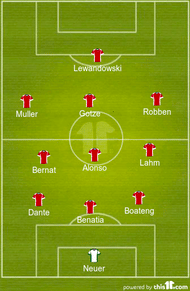
In possession, Lahm is expected to join in the attack doubling as a right winger, while Alonso screens the backline from any counters. This is fairly normal, to expect players to contribute to attacking transitions and it is a fairly easy move to carry out. The real magic of these two is seen without the ball, when they have to defend their goal with this unconventional and limited looking back line.
When the opposition attacks from the center, both stick to their positions while marshaling the forward players to fall back to create a compact shape. This causes an overload of players at the centre of the pitch, overwhelming the opposition and causing them to play errant passes or run.
When they attack from the right, the defense assumes this shape:
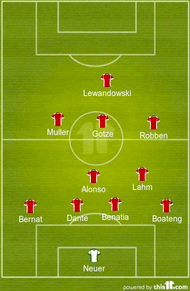
And this, when they're attacked from the left:
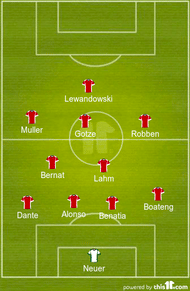
So in theory, Alonso and Lahm are playing in a wide range of positions ranging from box-to-box midfielder, winger and fullback to center back. To replicate this with any other players would be unthinkable as It is incredible what these two are doing for Bayern in this formation.
With Lahm's recent injury and subsequent long term lay-off, it'll be most interesting to see how they manage.
Rating: 10/10
